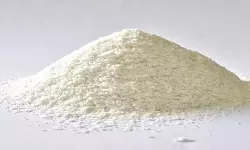IUPAC Name
Calcium Sulfate
Cas Number
7778-18-9
HS Code
2833.29.90
Formula
CaSO4
Industry
Fertilizers
Appearance
White Powder
Common Names
Gypsum
Packaging
25 kg PP woven bag
Calcium sulfate, also known as Gypsum, is a greyish to white coloured inorganic solid compound with a chemical formula of CaSO4. Calcium sulfate is present natural in the anhydrous form while the hydrous form exists naturally as Gypsum. Calcium sulfate can be used to manufacture various hemihydrates such as alpha hemihydrates and beta hemihydrates. Calcium Sulfate is highly insoluble in water at temperatures lower than or equal to room temperature. When partially hydrated, this calcium sulfate paste tends to set easily, thus allowing this product to be widely used in building materials.
The main sources of calcium sulfates are Gypsum or Anhydrite. Crude Gypsum rocks are sent to a rotary kiln and heated to remove any free moisture. These dried pieces of rocks are then sent to the roller/impact/or pulverizer mill where it is ground to the required size fractions.
Calcium sulfate, also known as Gypsum, is a greyish to white coloured inorganic solid compound with a chemical formula of CaSO4. Calcium sulfate is present natural in the anhydrous form while the hydrous form exists naturally as Gypsum. Calcium sulfate can be used to manufacture various hemihydrates such as alpha hemihydrates and beta hemihydrates. Calcium Sulfate is highly insoluble in water at temperatures lower than or equal to room temperature. When partially hydrated, this calcium sulfate paste tends to set easily, thus allowing this product to be widely used in building materials.
The main sources of calcium sulfates are Gypsum or Anhydrite. Crude Gypsum rocks are sent to a rotary kiln and heated to remove any free moisture. These dried pieces of rocks are then sent to the roller/impact/or pulverizer mill where it is ground to the required size fractions.
